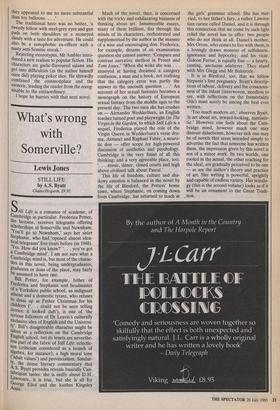What's wrong with Somerville?
Lewis Jones
STILL LIFE by A.S. Byatt
ChattolHogarth, £9.95
Still Life is a romance of academe, of Cambridge in particular. Frederica Potter, the heroine, receives telegrams offering scholarships at Somerville and Newnham; You'll go to Newnham,' says her sister Stephanie, who had 'opened almost iden- tical telegrams' five years before (in 1948). Yes. How did you know?". . . you've got a Cambridge mind'. I am not sure what a Cambridge mind is, but most of the charac- ters in this novel, being undergraduates, graduates or dons of the place, may fairly be assumed to have one.
Bill Potter, for example, father of Frederica and Stephanie and headmaster of a Yorkshire public school, an indignant atheist and a domestic tyrant, who refuses to dress up as Father Christmas for his children (`. . . could not be seen telling stories: it looked daft'), is one of 'the serious followers of Dr Leavis's culturally exclusive idea of English and the Universi- ty'. Bill's disagreeable character might be taken as a reflection on the Cambridge English school, but its tenets are neverthe- less part of the fabric of Still Life: eclectic- ism (criticism considered as a branch of algebra, for instance), a high moral tone ( adult values') and provincialism. Similar- ly, the dense literary commentary that A.S. Byatt provides reveals basically Can- tabrigian tastes: she is sniffy about D.H. Lawrence, it is true, but she is all for George Eliot and she loathes Kingsley Amis. Much of the novel, then, is concerned with the tricky and exhilarating business of thinking about art. Innumerable essays, many of them brilliant, fizz through the minds of its characters, orchestrated and supplemented by the author in the manner of a wise and encouraging don. Frederica, for example, dreams of an examination question she cannot answer: 'Compare and contrast narrative method in Proust and Tom Jones.' When she woke she was . . . annoyed at having dreamed a category confusion, a man and a book, not realising that the category error was partly the answer to the uncouth question . . .' An account of her sexual fantasies becomes a monograph on the history of European sexual fantasy from the middle ages to the present day. The two men she has crushes on — Alexander Wedderliurn, an English teacher turned poet and playwright (in The Virgin in the Garden, to which Still Life is a sequel, Frederica played the role of the Virgin Queen in Wedderburn's verse dra- ma, Astraea) and Raphael Faber, a neuro- tic don — offer scope for high-powered discussion of aesthetics and psychology. Cambridge is the very fount of all this thinking; and a very agreeable place, too: `. . . music, dance, closed courts and high above civilised talk about Pascal.'
This life of freedom, culture and sha- dowy emotion is balanced in the novel by the life of Blesford, the Potters' home town, where Stephanie, on coming down from Cambridge, has returned to teach at the girls' grammar school. She has mar- ried, to her father's fury, a rather Lawren- tian curate called Daniel, and it is through this connection that we come by such light relief the novel has to offer: two people who do not think at all. Daniel's mother, Mrs Orton, who comes to live with them, is a lovingly drawn monster of selfishness, ignorance and hypocrisy; and his vicar, Gideon Farrar, is equally fine — a hearty, canting, unctuous adulterer. They stand with Mrs Glegg and Mr Bulstrode.
It is in Blesford, too, that we follow Stepanie's first pregnancy. Byatt's descrip- tions of labour, delivery and the conscious- ness of the infant (interwoven, needless to say, with reflections on the Immortality Ode) must surely be among the best ever written.
`Too much modern art,' observes Byatt, `is art about art, inward-looking, narcissis- tic.' However one feels about the Cam- bridge mind, however much one may distrust didacticism, however sick one may be of novels that seem intended simply to advertise the fact that someone has written them, the impression given by this novel is not of a minor work. Its two worlds, one rooted in the actual, the other reaching for the ideal, are gradually perceived to be one — as are the author's theory and practice of art. Her writing is powerful, sprightly and capable of endless variety. Her tetralo- gy (this is the second volume) looks as if it will be an ornament to the Great Tradi- tion.


















































 Previous page
Previous page